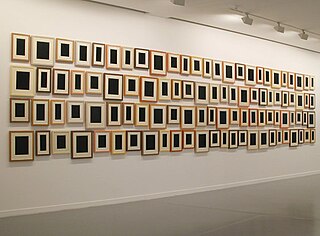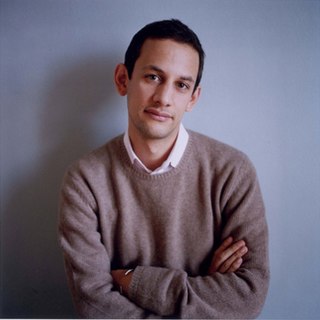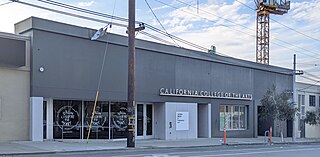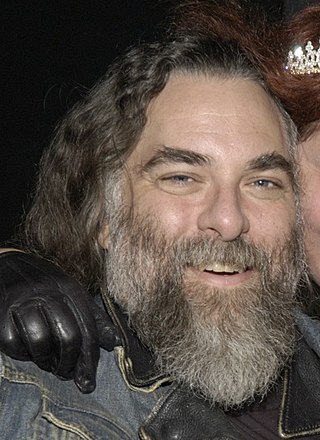Harrell Fletcher | |
|---|---|
| Born | 1967 (age 56–57) |
| Nationality | American |
| Education | California College of Arts and Crafts, San Francisco Art Institute |
| Known for | relational art, video art, performance, and sculpture |
| Notable work | Portland, Oregon |
| Movement | Social practice (art) |
Harrell Fletcher (born 1967 in Santa Maria, California) [1] is an American social practice and relational aesthetics artist and professor, living in Portland, Oregon.
Harrell Fletcher was born in 1967 in Santa Maria, California and attended Santa Maria High School. [2] Fletcher received his B.F.A. in 1990 from the San Francisco Art Institute (SFAI) and his M.F.A. in 1994 from California College of the Arts (CCA). [3] [4] At CCA, Fletcher studied under Suzanne Lacy.[ citation needed ] In 1995, Fletcher completed an apprenticeship at UCSC at the farm, studying ecological horticulture. [5]
In 2007, Fletcher founded the Art + Social Practice Program in the School of Art + Design at Portland State University, where he is still on faculty. [6] [7]
His fellow CCA student Jon Rubin, and Fletcher collaborated for several years in the Bay Area following the completion of his M.F.A., and together creating Gallery Here in nearby Oakland. [2] Gallery Here was in a vacant storefront in their Oakland neighborhood and it hosted neighborhood centered art exhibitions for a year. [2] The artists produced collaborative projects that occurred in non-traditional and municipally-managed art spaces. Fletcher became known for making projects in collaboration with strangers and non-artists.
With artist Miranda July, Fletcher founded the online arts project called Learning to Love You More (2002–2009). The project's website offered assignments to artists whose submissions became part of "an ever-changing series of exhibitions, screenings and radio broadcasts presented all over the world". [8] In addition to its internet presentations, Learning to Love You More has been compiled for exhibitions for the Whitney Museum, the Seattle Art Museum, and other hosts. [8] [9] A book version of the project's online art was released in 2007. [9] [10] The project is now part of the San Francisco Museum of Modern Art (SFMOMA) Collection. [11]
From 2010–2017, Fletcher co-curated with Jens Hoffmann the People's Biennial. [12] [13] The People’s Biennial explored and presented the creative activities of individuals and collectives as expressions of society’s cultural diversity that would otherwise be overlooked, neglected, or even actively repressed. [14]
Starting in 2014,[ citation needed ] Fletcher co-founded with Portland State University (PSU) faculty Lisa Jarrett, the King School Museum of Contemporary Art (KSMOCA), located within a preK-8 grade public school in northeast Portland, Oregon. [15] The museum opens to the public several times a year during art exhibition openings and special events, such as public lectures and an annual art fair. [16] KSMOCA had its first International Art Fair in 2017. [17]
Tender Feelings Press
During his residency at Marin Headlands Center for the Arts, Fletcher unpacked 33 years worth of accumulated refuse salvaged from his parents' attic, and invited anyone who stopped by his studio to take a piece of his past with them. [18] He also collected sundry stories written on scraps of paper by his friend Jess Hilliard, which he collated into the book, "Hi, Friend [19] ." (Alternate title: "Remember When We Used To Make Out. [20] ") So far, "Hi, Friend" is the only book published by Fletcher's Tender Feelings Press.
In 2002 he won the Creative Capital award. [21] He was a participant in the 2004 Whitney Biennial. [22] In 2005 he won the Alpert Awards in the Arts and a residency at ArtPace. [23]
In 2011, he was an artist in residence at Exploratorium, [24] and won an award from Americans for the Arts for Outstanding Public Artwork. He has been in residence at Capp Street Project at the Wattis Institute for Contemporary Arts in 2011. [25] In 2014, he was an artist in residence with his Portland-based art collective Public Doors and Windows (PDW) which includes artists Molly Sherman, and Nolan Calisch, at Institute of the Arts and Sciences (IAS) at University of California, Santa Cruz. [26]
Fletcher's work is held in the following permanent collections:
Indianapolis Museum of Contemporary of Art has now suspended Hoffmann from involvement in its upcoming People's Biennial (2018)

Miranda July is an American film director, screenwriter, actress and author. Her body of work includes film, fiction, monologue, digital presentations and live performance art.

Allan McCollum is a contemporary American artist who lives and works in New York City. In 1975, his work was included in the Whitney Biennial, and he moved to New York City the same year. In the late 1970s, he became especially well known for his series, Surrogate Paintings.

Jens Hoffmann Mesén is a writer, editor, educator, and exhibition maker. His work has attempted to expand the definition and context of exhibition making. From 2003 to 2007 Hoffmann was director of exhibitions at the Institute of Contemporary Arts London. He is the former director of the CCA Wattis Institute for Contemporary Art from 2007 to 2016 and deputy director for exhibitions and programs at The Jewish Museum from 2012 to 2017, a role from which he was terminated following an investigation into sexual harassment allegations brought forth by staff members. Hoffmann has held several teaching positions including California College of the Arts, the Nuova Accademia di Belle Arti and Goldsmiths, University of London, as well as others.

The Wattis Institute for Contemporary Arts is a nonprofit contemporary art center and research institute in San Francisco. It is part of the California College of the Arts. The institute holds exhibitions, lectures, and symposia, releases publications, and runs the Capp Street Project residency program.
Taraneh Hemami is an Iranian-born American visual artist, curator, and arts educator based in San Francisco. Her works explore the complex cultural politics of exile through personal and collective, multidisciplinary projects often through site specific installation art or participatory engagement projects.
Participatory art is an approach to making art which engages public participation in the creative process, letting them become co-authors, editors, and observers of the work. This type of art is incomplete without viewers' physical interaction. It intends to challenge the dominant form of making art in the West, in which a small class of professional artists make the art while the public takes on the role of passive observer or consumer, i.e., buying the work of the professionals in the marketplace. Commended works by advocates who popularized participatory art include Augusto Boal in his Theater of the Oppressed, as well as Allan Kaprow in happenings.

Nayland Blake is an American artist whose focus is on interracial attraction, same-sex love, and intolerance of the prejudice toward them. Their mixed-media work has been variously described as disturbing, provocative, elusive, tormented, sinister, hysterical, brutal, and tender.
Howard Fried is an American conceptual artist who became known in the 1970s for his pioneering work in video art, performance art, and installation art.
Learning to Love You More (LTLYM) was an American crowdsourced art project, where over 8,000 people posted work they had created in response to a series of prompts over a span of seven years. The project was created in 2002 by Miranda July and Harrell Fletcher, with a website created by Yuri Ono. In May 2009, the authors discontinued the project, ending with a final assignment asking people to "Say Goodbye." In 2010, SFMOMA acquired the work. The work has been exhibited at The Whitney Museum of American Art in New York, Rhodes College in Memphis, the Aurora Picture Show in Houston, The Seattle Art Museum in Seattle, the Wattis Institute for Contemporary Arts in San Francisco, and the San Francisco Museum of Modern Art.
Jordan Wolfson is an American visual artist who lives in Los Angeles. He has worked in video and film, in sculptural installation, and in virtual reality.
Aaron Flint Jamison is an American conceptual artist and associate professor in the University of Washington School of Art + Art History + Design. He works with various media including sculpture, publication, video, and performance.
Laylah Ali (born 1968) is an American contemporary visual artist. She is known for paintings in which ambiguous race relations are depicted with a graphic clarity and cartoon strip format. She lives in Williamstown, Massachusetts, and is a professor at Williams College.
Jennifer Pastor is an American sculptor and Professor of Visual Arts at the University of California Irvine. Pastor examines issues of space encompassing structure, body and object orientations, imaginary forms, narrative and progressions of sequence.
Bik van der Pol is the artists duo Liesbeth Bik and Jos van der Pol, who work together since 1994 as conceptual artists and installation artists.
Taravat Talepasand is an American contemporary artist, activist, and educator, of Iranian descent. She is known for her interdisciplinary painting practice including drawing, sculpture and installation. As an Iranian-American woman, Talepasand explores the cultural taboos that reflect on gender and political authority. Her approach to representation and figuration reflects the cross-pollination, or lack thereof, in our Western Society. Talepasand previously held the title of the chair of the painting department at San Francisco Art Institute (SFAI). She is an assistant professor in art practice at Portland State University.
Kota Ezawa is a Japanese-German American visual artist widely recognized for his artworks in which the subject is a source image, film, or news footage that Ezawa has redrawn in his distinctive visual style and remade as a video, mural, light box, sculpture, or in another medium.

The H Committee of Human Vindication, better known by its initials HCRH, is a Mexican art collective founded by Rodrigo Azaola, Artemio Narro and Octavio Serra that operated as a phantom and universal pseudo-organization, supposedly founded in 1947. The HCRH created numerous conferences, texts, actions, editorial projects, music, radio programs and artworks that utilize a highly ironic and intellectual language for "ridiculing the hollow pomposity of institutional culture." The public art activities of the HCRH, in festivals for example, were produced between 1996 and 2004, a period in which globalization and neoliberal politics in Mexico were incipient and the market-driven art world was consolidated.
Léonie Guyer is a contemporary artist based in San Francisco. She makes paintings, drawings, site-based work, prints, and artist books. Her post-minimalist abstract work is characterized by idiosyncratic shapes that are deployed in a variety of spaces.
Libby Black is an American contemporary artist working primarily in drawing, painting, and sculpture. Black lives and works in Berkeley California.